Tall fescue and Kentucky bluegrass are popular turf choices in the northern states of the US. Here we describe Tall Fescue vs Kentucky Bluegrass. Find the best turf for you.
When it comes to establishing the lawn of your dreams, choosing a suitable grass variety is arguably more important than anything else. With dozens of types to choose from, selecting the best grass for your lawn can be quite frustrating and tiresome. You will need to consider the climate and environment of your area and then determine which type of grass is better suited for your lawn. In addition, you will also have to consider your budget, lawn uses, and how you want your lawn to look!
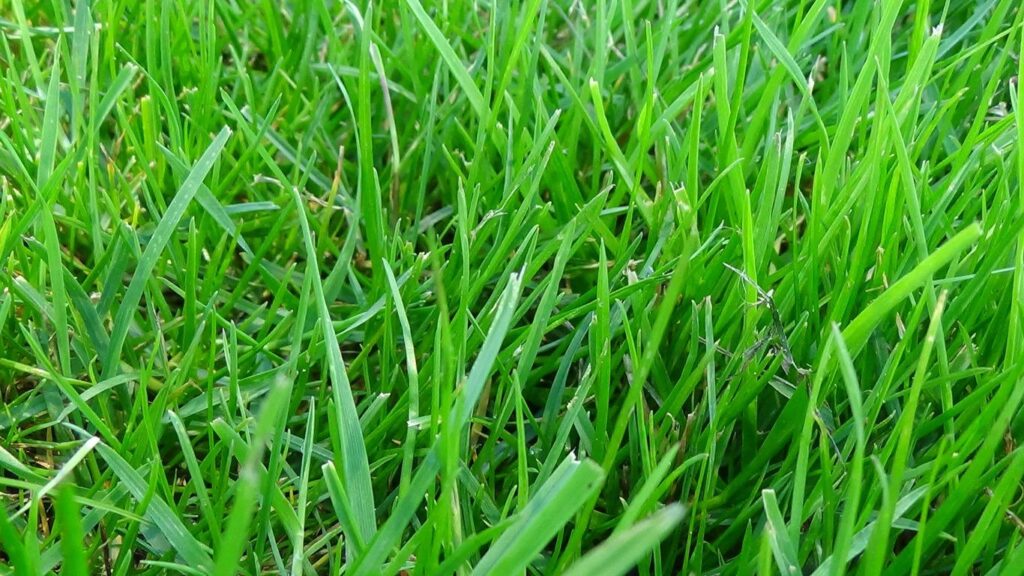
Kentucky bluegrass and tall fescue are two popular turfgrass choices in the north. However, they have some differences that might make one grass better for your lawn. For instance, Kentucky bluegrass has a softer texture when compared to tall fescue, but it requires more fertilizer and is not very tolerant to high foot traffic. In addition, Kentucky bluegrass is more prone to weeds and lawn diseases.
That is not to say that tall fescue is a better choice than Kentucky bluegrass. It also has its cons which are described in detail in the sections below. Keep reading to find out!
Tall Fescue Vs. Kentucky Bluegrass
Both Kentucky bluegrass and tall fescue grass are excellent choices when establishing a highly adaptable and easy-to-maintain lawn. And while both are cool-season grasses, there are slight differences between the two, and some of these differences can be a deal maker or breaker for you. These differences are:
Appearance
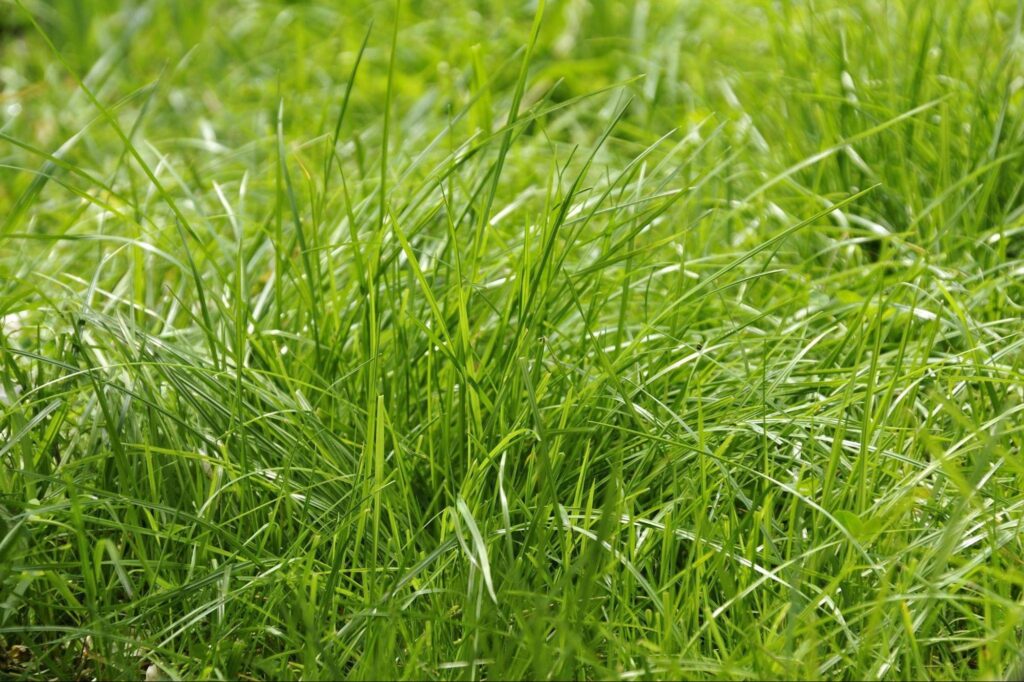
Tall fescue has a signature bunch-forming growth pattern.
Tall fescue is a coarse-textured, medium to dark green colored grass with a bunch type growth pattern. New leaves are rolled up when they emerge, while mature leaves are broad, ribbed and have shiny topsides. Tall fescue is known for its upright clumping growth habit and can maintain its color even in winter.
Kentucky bluegrass, on the other hand, has relatively thin and soft blades. In fact, it is one of the softest turf grass types. The grass is rich emerald to blue-green in color and gets the name “bluegrass” because of its unique seedheads. Kentucky bluegrass can be easily identified by its kneeled canoe-shaped leaf tip.
Watering Requirements
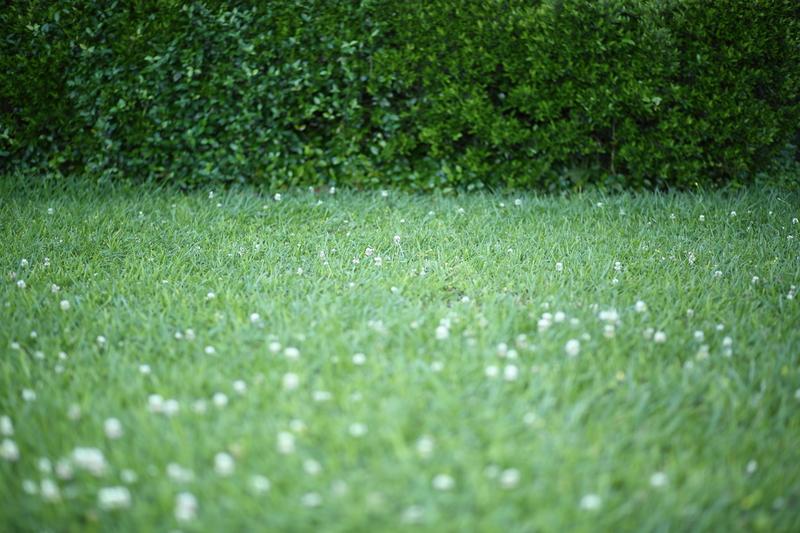
Both too much and too little water is harmful to the grass.
Tall fescue needs about one inch of water every week. Wilted, curled or folded leaves and dark-bluish-gray color indicate it is time to water your grass. Ideally, you should water your lawn deeply (until the soil is wet to a depth of 4 to 6 inches) and less frequently. It promotes the development of a deep and robust root system. Once established, tall fescue grass can tolerate several weeks of drought without rusting or going dormant.
In contrast, Kentucky bluegrass is not as drought resistant. Most lawns need at least 2 inches of water every week, and maybe even 2 ½ inches per week during the hot summer months. Moreover, there is a high chance that Kentucky bluegrass turfs will start rusting and go dormant if they are not watered.
Tall Fescue Soil Requirements
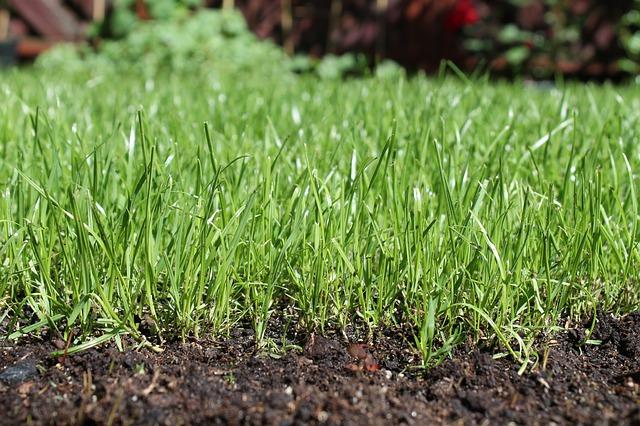
Maintaining soil pH is a must to grow a healthy lawn.
Although tall fescue grass can achieve admirable growth in low pH soils, it gives maximum yield when the soil pH is maintained between 6.0 and 7.5. In addition, tall fescue is not too picky about the type of soil. It grows well in a wide range of soil types. However, for best results, plant tall fescue in nutrient-rich soil with good fertility and drainage.
Like tall fescue grass, Kentucky bluegrass does well in well-drained, moist and fertile soils. However, it does not grow well in low or high pH soils. The ideal soil pH for the cultivation of Kentucky bluegrass is between 6.0 and 7.0. Moreover, compacted soil with low levels of organic matter can severely impact its growth.
Sun & Temperature Requirements
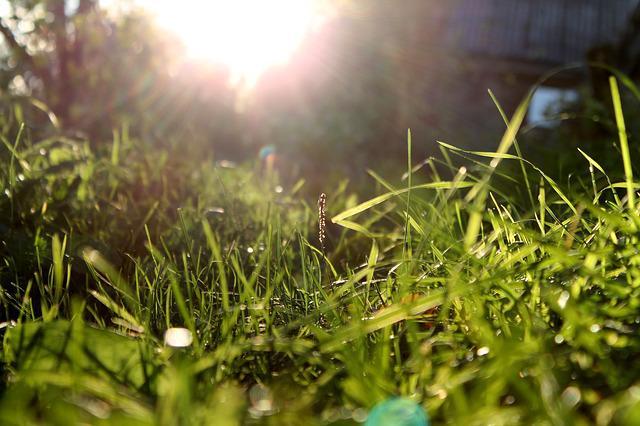
Kentucky bluegrass has poor shade tolerance when compared to the tall fescue grass.
In the cool-season grasses, tall fescue is probably the most shade tolerant grass. It requires only three to four hours of direct sunlight to produce maximum yield. However, make sure that you mow your tall fescue lawn a bit high (usually around four inches) so that it can absorb as much sunlight as possible. Tall fescue grass shows the max growth between 20 and 25°C, though it can grow in ambient temperatures of 15 to 30°C. However, it will go dormant once the temperatures go below 10°C or above 33°C.
Kentucky bluegrass also has somewhat similar temperature preferences. Its root growth peaks at 15°C and then declines sharply as the temperatures reach about 21°C. The root growth practically ceases as the temperature reaches around 26°C and above. However, unlike tall fescue, Kentucky bluegrass prefers full sun and requires at least six to eight hours of direct sunlight per day.
Fertilizer Requirements
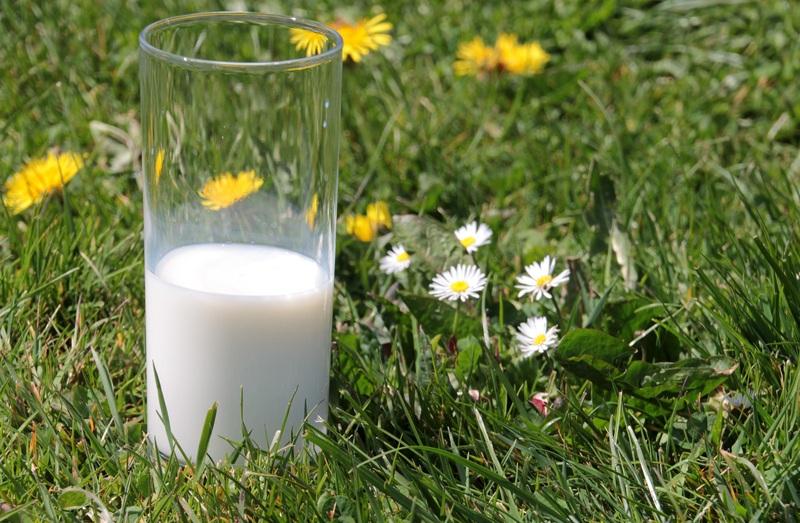
Kentucky bluegrass is more fertilizer-intensive when compared to the tall fescue grass.
Tall fescue grass needs a low to medium level of nitrogen fertility compared to the high level of nitrogen fertility required by Kentucky bluegrass. You will only need to apply about one pound of nitrogen fertilizer for a lawn area of 1000 square feet. However, Kentucky bluegrass needs about three to six pounds of nitrogen fertilizer per 1000 square feet of lawn.
When choosing a fertilizer or while fertilizing your lawn, one thing to keep in mind is carefully considering the soil chemistry. Sometimes your lawn soil might not even need to be fertilized, and overfertilization can harm the grass. So, always get a soil test before choosing and applying fertilizer to your lawn.
Mowing Requirements
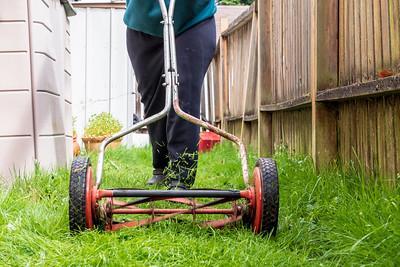
Mow the cool-season grass higher in warm months to provide insulation against heat.
The ideal mowing height for tall fescue grass is around 3.5 to 4 inches. Experts usually suggest mowing a tall fescue lawn to around a height of 2 to 3 inches during the cool weather and then increasing the mowing height to around 3½ inches before warm temperatures arrive. It keeps the soil well insulated against heat.
Similarly, Kentucky bluegrass lawns should be mowed at the height of 3 to 3½ inches and 2 to 2½ inches during the hot and cool months, respectively. Kentucky grass can also be mowed as short as one inch in the cool months; however, the shorter you cut your grass, the more frequently it will need to be mowed.
While mowing any grass, make sure that you do not cut the leaf blades more than one-third of their original length. It can damage or might even kill the grass.
RELATED: Kentucky Bluegrass For Lawns: Is It Any Good? A Comprehensive Guide
Durability & Uses
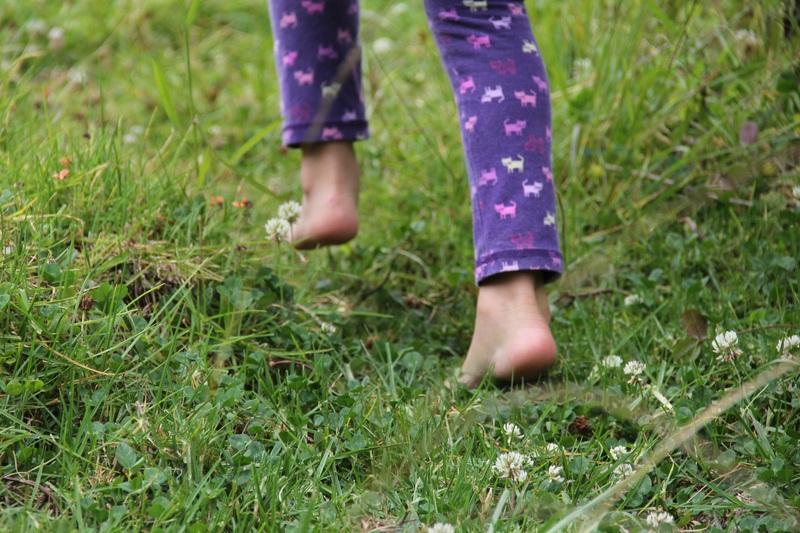
Due to its softness, Kentucky bluegrass is not well suited for high-traffic areas.
Tall fescue is one of the toughest varieties of grass that you can choose for your lawn. Its highly coarse leaves hold very well against high foot traffic. That’s not all, though! Tall fescue grass can also hold itself very well against damage from digging animals, muddy conditions, and soil compaction. All in all, tall fescue is an excellent choice for animal pastures, sports fields, walking trails and parking lots.
On the other hand, Kentucky bluegrass is better suited for areas with less foot traffic. Although it grows thick and recovers from damage rather quickly, its soft texture makes it highly prone to physical damage. That is why Kentucky bluegrass is better adapted for ornamental lawns and beautification and recreational uses.
Growth Pattern
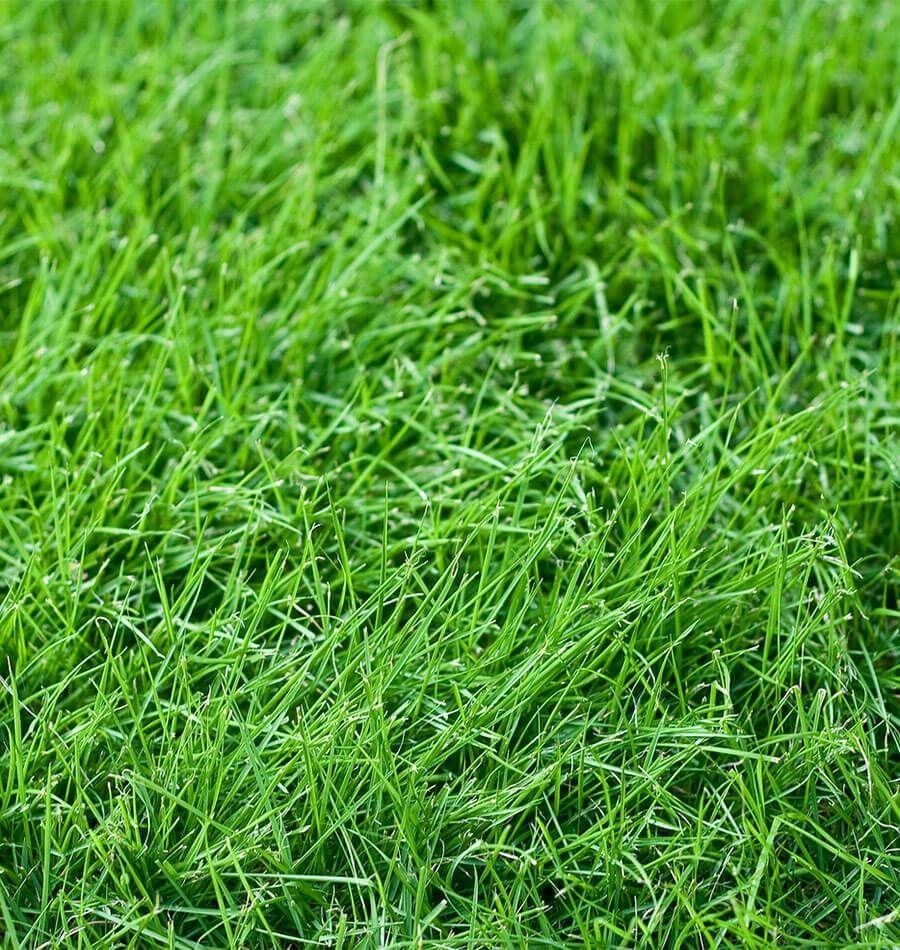
Tall fescue has a bunch-type growth habit and spreads main;y by erect tillers.
When choosing grass for your lawn, the way the grass grows and spreads can also make a huge difference. While tall fescue and Kentucky bluegrass are both rhizomatous grasses, they have completely different growth habits.
Germination Time
When it comes to germination, seeds of Kentucky bluegrass take longer to germinate. In ideal situations, Kentucky Bluegrass takes about three weeks to germinate. Tall fescue, however, can germinate in as little as 7 to 14 days under optimum conditions.
Sod Formation
Kentucky bluegrass creates a dense sod and spreads rapidly, covering any bare spots in the yard. In contrast, tall fescue develops a bunchy sod that might result in the occasional formation of bare patches which need to be overseeded.
Root System
Tall fescue has a very robust and deep root system. It is the reason why this grass is a popular choice for clay and sandy soils where other grasses struggle to grow. Its roots can go as deep as four to six feet as compared to the 2 to 3 feet deep roots of Kentucky bluegrass.
Tolerance Against Weeds & Diseases
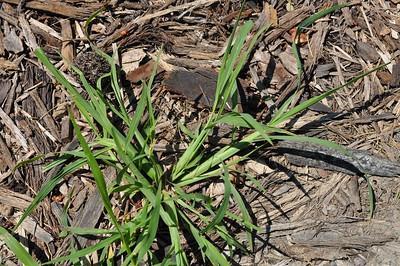
Crabgrass: a common weed of both tall fescue and Kentucky bluegrass turfs.
Kentucky bluegrass and tall fescue grass are not more susceptible to lawn diseases, weeds and insect pest problems than any other type of turfgrass. Moreover, both recover from damage rather quickly and hold themselves well against common fungal diseases. Tall fescue is, however, quicker to recover from damage than Kentucky bluegrass.
Thatch Formation
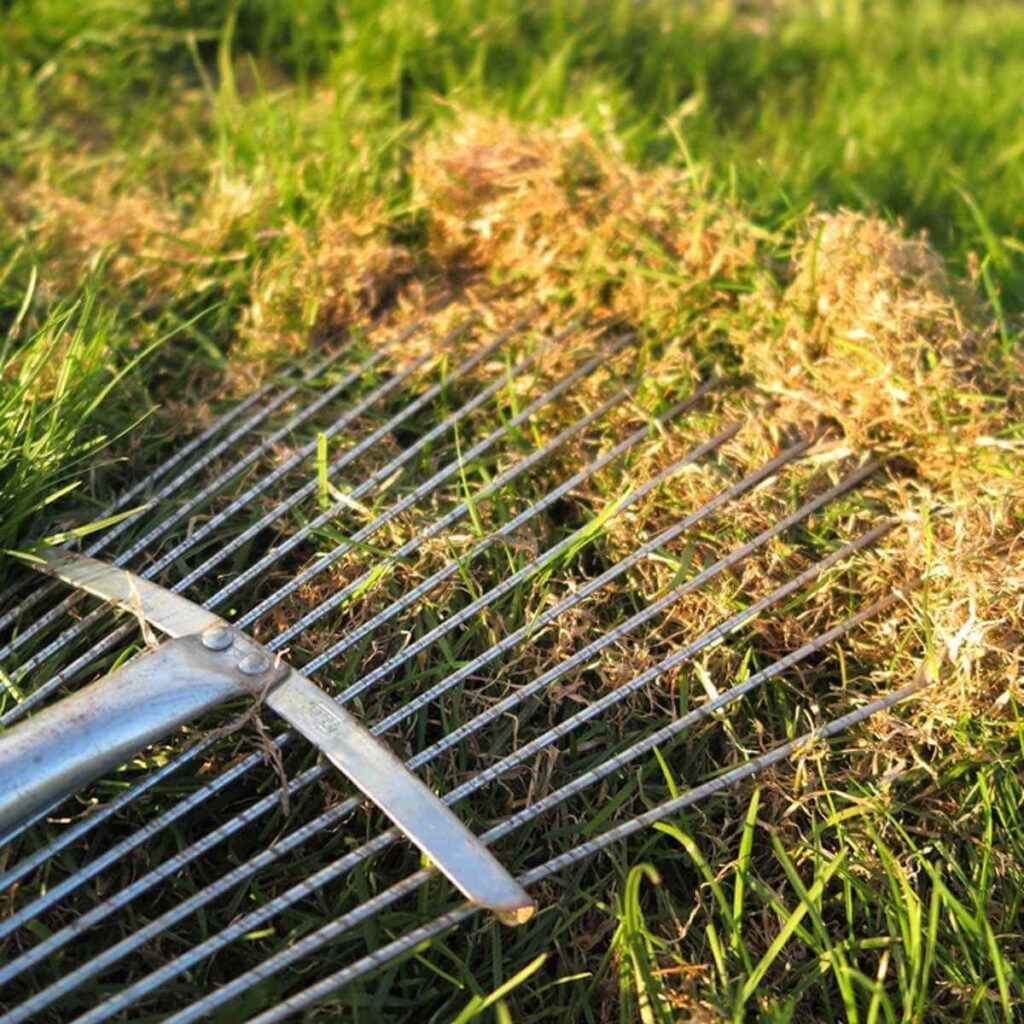
Thatch buildup can decrease fresh air, water and nutrient availability to grass.
Thatch is a mix of dead and living plant material, and it forms naturally as a result of ever ongoing wear and tear of the grass. A thick layer of thatch can prevent the fresh air, water and nutrients from reaching the grassroots, which is detrimental to the lawn.
Since tall fescue is coarse grass and it is very resistant to mechanical damage, thatch rarely builds up in significant quantities, and a tall fescue lawn rarely needs dethatching.
However, thatch buildup is a significant problem for Kentucky bluegrass, mainly due to its soft texture, and it needs to be detached every year or two.
Tall Fescue Vs. Kentucky Bluegrass | Quick Comparison
| Character | Tall Fescue | Kentucky bluegrass |
|---|---|---|
| Color | Medium to dark green | Deep emerald blue-green |
| Durability | More durable | Less durable |
| Extra Care | Does not need dethatching but can benefit from overseeding | Needs dethatching |
| Fertilizer Requirement | One pound of nitrogen fertilizer per thousand square feet of lawn | 4 to 6 pounds of nitrogen fertilizer per thousand square feet of lawn |
| Grass Type | Cool-season perennial C₃ species of bunchgrass | Cool-season perennial smooth meadow grass |
| Growing Season | Best growth in cool spring and fall | Best growth in cool spring and fall |
| Growth Habit | Bunchy and clumpy | Dense carpet like |
| Growth Patterns | Tiller spreading / bunch-forming / limited spreading capabilities | Shallow rhizomatous/ self-spreading, sod-forming |
| Hardiness | Exceptionally hardy in transition zones | Incredibly hardy in colder climates |
| Ideal Time to Plant | Spring and fall | Early Fall |
| Mowing Requirements | 3.5 to 4 inches | 2 to 3 inches |
| pH | 6.0 to 7.5 | 6.0 to 7.0 |
| Resistance | More resistant to weeds and disease | Less resistant to weeds and disease |
| Soil | Rich and clay soil | Well-drained and moist soil |
| Sturdiness | Limited capabilities for self-repairs; but more tolerant to foot traffic | Self-repairs from damage; but less tolerant to foot traffic |
| Sunlight | 4 hours of direct sunlight per day | 8 hours of direct sunlight per day |
| Texture | Coarse and clumpy | Soft: easy on bare feet |
| Uses | High traffic areas, animal pastures, sports fields, walking trails and parking lots | Ornamental lawns and in beautification and recreational settings |
| Water Requirements | One inch per week, quite drought-resistant | 2 to 2 ½ inches per week |
Tall Fescue Vs. Kentucky Bluegrass | Which You Should Choose?
Depending on where you live and how you want your lawn to look and be used, one of these two types of grass might be better than the other. For instance, if you live far north, you should go with Kentucky bluegrass as it is better suited for the colder regions.
On the other hand, if you are in the transition zone or slightly south, you should choose tall fescue grass. However, many varieties of tall fescue grass available today in the market have netter cold tolerance and can be used in the far north.
Similarly, the best choice depends on how you want to feel or use like. For instance, if you hold a lot of outdoor gatherings, you should go with tall fescue. However, if you want a soft green turf near your pool, Kentucky bluegrass is the best choice.
Nonetheless, both types of grass are excellent choices for the people living in cool-season areas. With some care, you can establish a lush lawn with any of these two types of grass.
Frequently Asked Questions (FAQs)
Can I mix Tall fescue and Kentucky bluegrass together?
Kentucky bluegrass and tall fescue grass coexist with each other very well. It is very unlikely that one grass will choke out the other. So, if you have a lawn with mixed shade, tall fescue grass can cover the shady spots of your lawn and Kentucky grass can provide your lawn with a soft texture that tall fescue entirely lacks.
What is the difference between tall fescue and Kentucky 31?
Kentucky 31 tall fescue is a variant of tall fescue grass with superior heat, cold and drought tolerance. Natural tall fescue also has good heat and drought tolerance, but it goes dormant when temperatures become too high or too low.
Where does tall fescue grow best?
Tall fescue is a cool-season grass and is well-suited for the lawns in the country’s northern areas. However, due to its good heat tolerance, it also does very well in the transition areas where warm-season and cool-season grasses hit their climate limits.
Where does Kentucky bluegrass grow best?
Like tall fescue grass, Kentucky bluegrass is a cool-season grass and suited for lawns in the north of the United States. However, it needs six to eight hours of sunlight per day and does not do well in too acidic or too alkaline soils.
Is tall fescue finer than Kentucky bluegrass?
Both Kentucky bluegrass and tall fescue grass produce a dark green turf and have fine grass blades. However, the grass blades of tall fescue are rough and scratchy, whereas the grass blades of Kentucky bluegrass are soft to touch.
Does tall fescue grass turn brown in winters?
Tall fescue grass is a cool-season grass that has good cold tolerance. If temperatures are not extremely low, it tends to maintain its green color though some yellowing may occur.
Does Kentucky bluegrass stay green in winter?
Kentucky grass stays reasonably green during the winter months, just like its main competitor, tall fescue, given that the temperatures do not become too low. Once the sod goes dormant, it will take some time before the lawn greens up again.
Sources For Further Reading
Tall Fescue: An Alternative to Kentucky Bluegrass – Iowa State University Extension & Outreach
Mixing Tall Fescue with Kentucky Bluegrass and Perennial Ryegrass – University of Missouri Turfgrass Research Center
Selecting the Right Grass for Your Kentucky Lawn – University of Kentucky, Cooperative Extension Service







